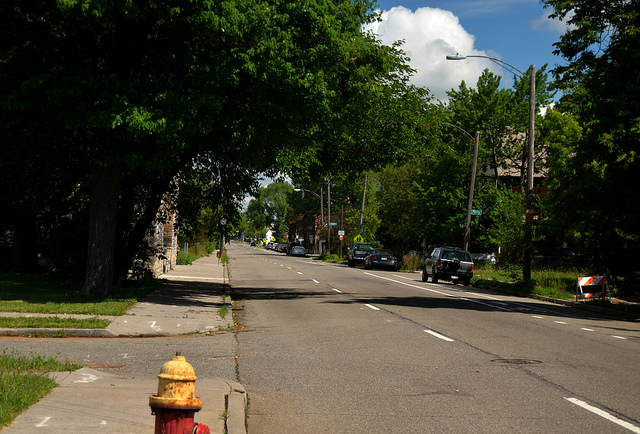
Evidence shows that trees and green spaces in urban areas offer a number of benefits, such as reducing stress and improving air quality. Despite these benefits, many residents of Detroit refused to allow the city to plant trees in front of their houses during a recent city “greening” initiative. An article appearing in CityLab draws from sociological research to demonstrate how a history of government abuses and lack of inclusivity of communities of color in key decisions explains why many Detroiters had this reaction.
Sociologist Dorceta Taylor published a report in 2014, arguing that white environmentalists make environmental justice projects less effective when they assume they know what is good for a neighborhood. By leaving communities of color out of the planning process, they are not able to anticipate or overcome challenges along the way. This proved true in Detroit. A recent article by Christine Carmichael and Maureen McDonough examined the reasons why Black residents resisted the city’s trees. CityLab reports: “It’s not that they didn’t trust the trees; they didn’t trust the city.”
Carmichael and McDonough found that Black residents were aware of the many benefits of living near trees. However, to some, the trees were a symbol of the city’s unwanted intervention in their lives. Amidst racial tension in the 1960s, the city began clearing trees from Black neighborhoods — ostensibly to combat Dutch elm disease, but some interviewees. Yet, some people believed the city cut down trees to increase police surveillance. This memory triggered their reaction to the modern tree-planting. Carmichael says:
“In this case, the women felt that [after the race rebellion] the city just came in and cut down their trees, and now they want to just come in planting trees. … But they felt they should have a choice in this since they’ll be the ones caring for the trees and raking up the leaves when the planters leave. They felt that the decisions regarding whether to cut down trees or plant new ones were being made by someone else, and they were going to have to deal with the consequences.”
This failed initiative in Detroit highlights the social forces that environmental organizations must consider when working in marginalized neighborhoods. Recruiting volunteers and administrators who come from the communities they are serving (something Detroit did not do) could help improve the process. As CityLab reports:
“[E]nvironmental justice is not just about the distribution of bad stuff, like pollution, or good stuff, like forestry projects across disadvantaged communities. It’s also about the distribution of power among communities that have historically only been the subjects and experiments of power structures.”

Comments 10
Wilma — August 31, 2022
I appreciate the advice; I'll read the remaining parts. As arborists, cutting down a tree is the most dangerous aspect of our work. Trees frequently flourish close to homes, power lines, and other constrained areas. The tree removal specialists at https://heartytreeguys.com/tree-removal/ can do the operation quickly and efficiently using the necessary tools. That's how easy it is. They are capable of handling any size tree. They are prepared to assist, no matter how little the tree, if you are unable to remove it for whatever reason.
kaminagulam — September 16, 2022
This are the great person things It's shows how great you are..
Iraqi Dinar Guru
Mark Smith — January 16, 2023
How would this work? Like other ecological interactions, cooperation must evolve by natural selection, in which traits increase in frequency because individuals who have them produce more offspring and pass on the traits. Myherbalife
Eleanor Tse — January 19, 2023
I would like to thank the author of this post. I have learned a lot of good things from this post. This information has increased my knowledge tremendously. While I was reading this post, I came across a link to the chat gpt 3 websites. When I found out about that website. Then I came to know that there is a free AI tool on this website which you can learn to use for free.
Alfonzoe — February 12, 2023
Hi, I'm really impressed with the photo you shared in cover photo. Can you pls confirm that where it's situated in Seattle or USA? Actually, I'm interested to open my traveling company's office here because of its amazing location. Check our business here to get a better idea. We're open o suggestions. Thanks!
Ben Foakes — March 4, 2023
Hi, is it possible to generate image while giving the data to any tool or converter in the form of text? What about ai image generator or image generator from text?
gmglobalconnect login — August 17, 2023
thanks for sharing. it is wonderful note.
GMGlobalConnect login
receiptify spotify — August 27, 2023
It's nice to see events like this that cater to the varied interests of people who are passionate about motorbikes by providing a variety of activities—including customisation, entertainment, and the chance to network with other riders. Additionally, it appears that the event places an emphasis on the community and the shared excitement among bikers. receiptify spotify
cfa.home — September 5, 2023
It's nice to see events like this that offer something for everyone who loves motorcycles, like customising, entertainment, and the chance to meet other riders. Also, it looks like the event puts a lot of stress on the biker community and how excited everyone is. cfa home
Olivia — April 9, 2024
When the right time to prune shrubs and trees depends on the tree species and type of pruning. Ornamental shrubs, as a rule, are pruned annually - only in this case do they retain the desired shape. Fruit trees do not need to be pruned every year; this procedure is carried out every 4-6 years. In particular, young trees should be pruned more frequently to prevent abnormal growth, such as trunk splitting. If you don't know where to start, you can always ask tree service Las Cruces for help